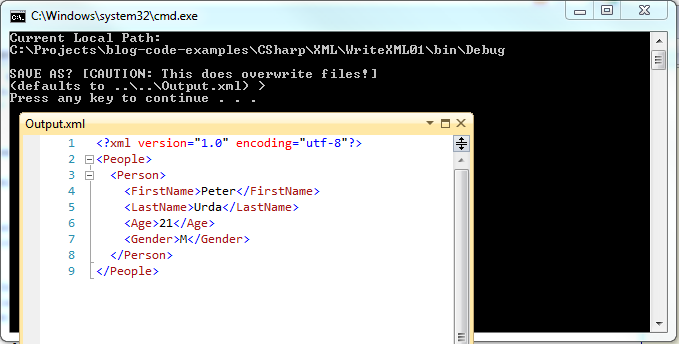Write to XML with C#
So we can read XML in a variety of ways (one example here, and another here). So can we write it in C#? Of course we can! So lets jump right into shall we?
So here is the steps I take in this sample:
using System;
using System.Xml;
namespace WriteXML01
{
// Let's establish a generic Person Class, and define necessary methods
class PersonObject
{
public string fname { get; set; }
public string lname { get; set; }
public int age { get; set; }
public char gender { get; set; }
public PersonObject(string f, string l, int a, char g)
{
this.fname = f;
this.lname = l;
this.age = a;
this.gender = g;
}
}
class WriteXML01
{
static void Main(string[] args)
{
// Let's Build a few people
PersonObject PeterUrda = new PersonObject("Peter", "Urda", 21, 'M');
// Lets define an XML document
XmlDocument XMLDoc = new XmlDocument();
// Create an XML declaration
XmlDeclaration XMLDec =
XMLDoc.CreateXmlDeclaration("1.0", "utf-8", null);
// Create the root of the XML file
XmlElement RootNode = XMLDoc.CreateElement("People");
// Make sure the declaration gets inserted before the XML root
XMLDoc.InsertBefore(XMLDec, XMLDoc.DocumentElement);
// Add the root
XMLDoc.AppendChild(RootNode);
// Make an object to store the elements in
XmlElement PersonToXML = XMLDoc.CreateElement("Person");
// And add that to the XML document
XMLDoc.DocumentElement.PrependChild(PersonToXML);
// Make the Elements
XmlElement FNameNode = XMLDoc.CreateElement("FirstName");
XmlElement LNameNode = XMLDoc.CreateElement("LastName");
XmlElement AgeNode = XMLDoc.CreateElement("Age");
XmlElement GenderNode = XMLDoc.CreateElement("Gender");
// Load the info for the text information
XmlText FNameText = XMLDoc.CreateTextNode(PeterUrda.fname);
XmlText LNameText = XMLDoc.CreateTextNode(PeterUrda.lname);
XmlText AgeText = XMLDoc.CreateTextNode(PeterUrda.age.ToString());
XmlText GenderText =
XMLDoc.CreateTextNode(PeterUrda.gender.ToString());
// Add the elements into the object
PersonToXML.AppendChild(FNameNode);
PersonToXML.AppendChild(LNameNode);
PersonToXML.AppendChild(AgeNode);
PersonToXML.AppendChild(GenderNode);
// Add the text into the elmemnts
FNameNode.AppendChild(FNameText);
LNameNode.AppendChild(LNameText);
AgeNode.AppendChild(AgeText);
GenderNode.AppendChild(GenderText);
// Prompt the user where to save to, provide the current local
// directory if the user wants to use a relative path.
Console.Write("Current Local Path: \n");
Console.WriteLine(Environment.CurrentDirectory);
Console.Write("\nSAVE AS? "
+ "[CAUTION: This does overwrite files!]\n"
+ "(defaults to ..\\..\\Output.xml) > ");
string UserPath = Console.ReadLine();
// Nothing? Default to something.
if (UserPath == "")
{
UserPath = "..\\..\\Output.xml";
}
// Try/Catch issues
try
{
XMLDoc.Save(UserPath);
}
catch (Exception e)
{
Console.WriteLine(e.Message);
Environment.Exit(1);
}
Environment.Exit(0);
}
}
}
First I make a generic person class to store my data in, and get it back out for the XML later. This could resemble an object we could get from a data factory or a SQL database. But it is an object nonetheless.
We then define the declaration of the document, it just states what version and encoding we are using in this specific XML file. We then use some XmlDocument methods to make sure that a root node (People in this case) is created and that our declaration is stuck right before it.
Once that is all said and done, we create a parent node, PersonToXML in this case, and add it after our root node with PrependChild.
We then use multiple lines of code create the Elements for our XML object, and the text they will contain. We use even more XmlDocument methods to add these in order to build our logical structure. Finally, we get a path from the user, catch exceptions if needed, and write the XML file.
Here is the output we get when we run the program:
The file overwrites Output.xml each time it is ran, and it produces the same results every time (surprising, I know). So be careful!
Pretty simple huh? Just add some loops or database calls, and you can be using XML for just about anything you can think of!
